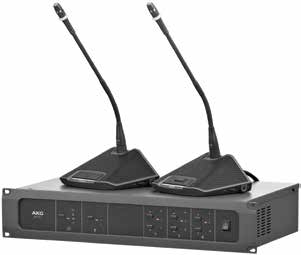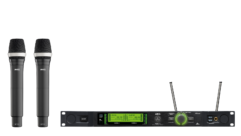

AKG’s flagship DMS800 Reference Digital Wireless Microphone System is the successor to the company’s well-received DMS700 V2, gaining some new functionality and features to increase its usefulness such as 512-bit encryption and a 150MHz frequency range for worldwide touring flexibility. It offers both Dante and AES/EBU digital audio outputs, and the DHT800 handheld transmitter has been upgraded; its microphone heads are now exchangeable. Additionally, the mute switch of the transmitter may now be set to work as a power switch. The DMS800 can be outfitted with the AKG D5 WL1, D7 WL1, or C5 WL1. Further, the DMS800’s optional network remote control allows frequency coordination and monitoring of multichannel systems by PC software Audio Architect, Apple iPhone/iPad/iPod, or Soundcraft Vi consoles.
Audio Ltd.’s 1010 is a ruggedly built, world-class digital wireless microphone system featuring 100MHz of switching bandwidth. Encased in a black anodized chassis that’s machined from solid, high grade aluminum, the TX1010 transmitter distinctively features rounded corners and recessed buttons. Up to 20 systems can be operated together in one TV channel thanks to a proprietary modulation system allowing high channel density. Features include an end-to-end delay of 2mS, crystal-clear OLED menu on both the transmitter and receiver with select and- click displays for streamlined operation, and much more. Audio Ltd. offers a free downloadable app allowing main function via smart device.

Having had considerable experience in using Audio-Technica’s System 10 PRO wireless system—a well-received 2.4GHz wireless system platform offering user-friendly operation via half-rack chassis with two receiver unit slots—I am hardly surprised that the company has continued to expand the line. They now offer two more 2.4GHz transmitters, which I reviewed: the ATW T1006 Boundary Microphone Transmitter and ATW-T1007 Microphone Desk Stand Transmitter, both of which are extremely useful tools in house-of-worship, commercial/corporate, theater, and a wide range of installed audio environments. At January’s NAMM Show, Audio-Technica incorporated these two new transmitters as part of two new packaged configurations, the ATW-1366 System 10 PRO Rack-Mount Digital Wireless System with Boundary Microphone/Transmitter and ATW-1377 System 10 PRO Rack-Mount Digital Wireless System with Microphone Desk Stand Transmitter. Previously, the ATW-T1006 and ATW-T1007 were available as individual components. According to the company, the transmitters and receivers are now available together as turnkey packages to simplify the ordering process.

Audix’s Performance Series of wireless products began shipping last summer and has received impressive reports from the field thus far. The Performance Series is divided into two groups: The 40 Series and the 60 Series, both of which are available in single and dual rack models. Common system features include one-touch auto scan searches; one-touch sync links transmitter to receiver via infrared beam; RF and AF indicators; high-contrast LCD displays; simplified, intuitive menus and a metal chassis; soft keys to control output levels, squelch, pilot, and lockout; choice of XLR or quarter-inch outputs; and a wide selection of handheld, instrument, headworn, and lavalier microphone options. The R42 is a two-channel diversity receiver including antennas, power supply, rack mount, and BNC cables for front mounting antennas. By adding the ADS48 antenna distribution system, a total of four R42 systems (eight channels of wireless) will fit into five rack spaces, operable from one antenna set.

German manufacturer beyerdynamic has introduced a new version of its 24-bit TG 1000 Wireless System featuring its dual receiver equipped with a Dante network interface via RJ45 connector with status LEDs on its rear panel. As such, the TG 1000 receiver offers both analog and digital output, the latter of which is ready for the flourishing Dante AoIP protocol by Audinate. Features of the German-made beyerdynamic TG 1000 include switching bandwidth of 319MHz in the UHF range (470MHz to 789MHz); high-contrast OLED UI display; one-button navigation; beyerdynamic’s own Chameleon software; optional proprietary encryption; and an impressive 2.1ms transmitter-to-receiver total latency. Up to six dual receivers can be cascaded without the need for external antenna splitters. In optimal environmental conditions, the TG 1000’s transition range can reach up to 984ft.

I recently reviewed CAD Audio’s CADLive WX3000 UHF Wireless Series package in both club and house-of-worship environments. It benefits from having a handheld transmitter; the rugged, frequency-sculpted, and high SPL-handling D90 capsule paired with a new generation CAD receiver offering attractive, cost-effective features. The system features the D90-equipped handheld transmitter and body pack transmitter for Hi-Z guitar and Lo-Z microphone input, all within a handy polypropylene carrying case. The included CADTone body pack includes Equitek E19 earworn and E29 lavalier microphones, too. In use, I found the WX3000 to be an intuitive and superb-sounding UHF wireless rig, especially considering its relatively low street price. Its metal-clad handheld transmitter feels especially well made to the touch and resembles handheld transmitters from systems costing hundreds more; its recessed SoftTouch multifunction on/off/mute switch is a great example of its confidence-bolstering component-level quality.

Electro-Voice’s RE-2 PRO Wireless System is a blend of pro-grade features and affordability, featuring one-touch Auto-ClearScan and full programmability, positioned in between E-V’s REV and RE-2 offerings. Other features include Posi-phase diversity, more than 28MHz operation, XLR mic/line level output, backlit LCD display, and a unique “guitar optimized” mode. The WTU-2 is a compact metal bodypack for the RE-2 system. Already compatible with the Telex RSB-2 mute switch for sports applications, the WTU-2 features selectable RF output power and rechargeable AA battery operation with optional BH-200 charger.

World-class wireless experts Lectrosonics has introduced version 4.0 firmware for its IFBR1a belt-pack receiver, adding new functionality in two distinct user interface modes: Scan Mode, exhibiting the original behavior of the IFBR1a receiver where users can locate and store up to five different IFB carrier frequencies by scanning for them; and Direct Entry Mode, which takes away the scan capability and replaces it with the ability to program channels into the memories directly via the pushbutton and hex switches. In Direct Entry Mode, five additional channel memories are available for a total of 10. IFBR1a users can identify the difference between a v4.0 IFBR1a in Scan Mode and a v2.4 IFBR1a by a burst of rapid LED blinks at power-on in the v4.0 version, indicating that the unit has two modes available; the first of those two modes is selected.

Line 6 has been doing 2.4GHz digital wireless for quite some time now, finding enthusiastic customers in the DIY musician sector and gaining ground in fully-pro applications, too. The company’s XD-V Wireless Microphone Series is super intuitive, sounds great, and offers unique features such as built-in microphone modeling based on the industry’s top 10 most popular live handhelds and nine EQ filters for further flexibility. The XD-V system is configurable as a lavalier, headset, or bodypack system.
I reviewed one of the first XD-V systems available in the marketplace years ago and absolutely loved using it. US Distributor Avlex is now shipping Mipro’s new ACT 2400 Series wireless systems. The series includes both single- and dual-channel half-rack receiver systems with various transmitter options, all of which utilize the 2.4GHz ISM band and offer 4-frequency FSK (frequency shift key) modulation circuitry, as well as a Frequency Hopping Spread Spectrum technology utilizing four frequencies for each channel in an adaptive tracking algorithm that is said to avoid interference from 2.4GHz products on channels 1, 6, and 11. The systems employ dual-tuner true digital diversity reception and reportedly provide 12 compatible simultaneous channel operations at receiving distances up to 100 meters (330ft.). Both the ACT-2401 single channel systems, and ACT-2402 dual channel systems include the MP-80 smart charging cradle.

Revolabs has continued to deploy its flagship Executive Elite wireless microphone system, while also expanding into other aspects of conferencing and collaboration since being acquired by Yamaha three years ago this month (most recently the CS-700 huddle room videoconferencing product). The Executive Elite comes in 2-, 4-, or 8-channel models and may be used with any combination of 4-8 tabletop, wearable, and gooseneck microphones. The award-winning system is respected for it’s classy boardroom-friendly looks and its scalable distributed architecture. Executive Elite separates the remote antenna receiver unit from base DSP unit. The remote antenna receiver and base DSP units are connected via a standard Cat-5e or Cat-6 cable supporting PoE and simplifying distributed or in-room installations. When ceiling or wall mounted, the remote antenna receiver can be in the same room as the wireless microphones regardless of where the receiver base DSP unit is located. Revolabs synchronization technology enables receivers in relative proximity to one another to synchronize, thus allowing deployments of multiple Revolabs Executive Elite receivers to optimize the available audio channels—users can introduce 44 or more microphones in one area.

Sennheiser’s new and buzzed-about Digital 6000 professional wireless microphone series is now shipping, so we’re going to spend a little additional time on it. The new offering is a 2-channel solution in one rack; it notably shares Sennheiser’s Long Range transmission mode and proprietary audio codec with the company’s Digital 9000 flagship. The Digital 6000 is designed to be a flexible 2-channel wireless solution, allowing the use of existing accessory infrastructures to best fit the needs for theaters, rental companies, churches, etc. It is compatible with Digital 9000 in long-range mode and with the EK 6042 digital/analog camera receiver. The series is comprised of a 2-channel receiver, the EM 6000, available with two different packages featuring a bodypack or a handheld transmitter, each with a 1U rack-mount 19in. charging unit. The receiver’s switching bandwidth of 244MHz (470MHz to 714MHz) is covered by three transmitter versions, and up to eight receiver units can be daisy-chained without the need for an additional antenna splitter. The multichannel system will work with a single pair of antennas. System latency is 3 milliseconds. The EM 6000 receiver is fitted with a digital AES-3 output with wordclock in/out, transformer- balanced analog XLR-3 outputs and quarter-inch jack outputs. A Dante-ready version, the EM 6000 Dante, offers an additional Amphenol RJ-45 connector for integration into any Dante network. For data security, a feature that is particularly important for conference and corporate use, Digital 6000 features switchable AES 256 encryption, with the transmitters also supporting the proprietary encryption of the Digital 9000 system. Digital 6000’s transmitters use the same rechargeable packs as their Digital 9000 counterparts. As the SKM 6000 handheld transmitter features Sennheiser’s standard capsule interface, it can be used with any microphone head from the evolution wireless Series, the 2000 Series, and also with 9000 Series heads.

Meanwhile, Shure continues to expand the reach of its Axient, QLX-D, and ULX-D wireless microphone systems with further integration with Yamaha CL and QL series mixing consoles. In Yamaha’s firmware version 4.1, users may monitor and control key features of such Shure wireless systems from mix position. With this upgrade, users can do all of the following: discover connected wireless systems; identify and map each system to a desired input channel; monitor transmitter battery status, RF, and audio signal level; and adjust receiver audio output level when Shure AXT400, QLXD4, or ULXD4 digital receivers are connected to the same network as a Yamaha CL or QL series console. Further, with Axient wireless systems, transmitter input gain can be controlled remotely from the mixing console via ShowLink Access Point.
High-end wireless expert Zaxcom is now shipping its tiny ZMT3 Miniature Transmitter, which is just about as small as you will find in the industry. According to Zaxcom, a single 6MHz U.S. television channel can contain up to 60 channels of Zaxcom ZHD wireless when used with a QRX300 receiver spaced 100kHz. And thanks to the ZHD’s efficient modulation, it is capable of truly incredible transmission distance. The ZMT3 transmitters are available as 3.5 (518MHz to 614MHz) and 3.6 (596MHz to 698MHz).












